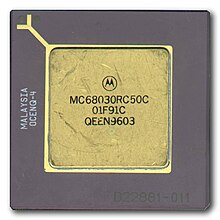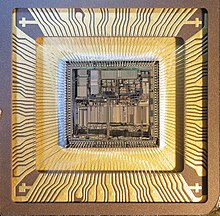
Back موتورولا 68030 Arabic Motorola 68030 Czech Motorola 68030 German Motorola 68030 Greek Motorola 68030 Spanish Motorola 68030 Finnish Motorola 68030 French Motorola 68030 Hungarian Motorola 68030 Italian MC68030 Japanese
 | |
| General information | |
|---|---|
| Launched | 1987 |
| Designed by | Motorola |
| Performance | |
| Max. CPU clock rate | 16 MHz to 50 MHz |
| Data width | 32 bits |
| Address width | 32 bits |
| Cache | |
| L1 cache | 256 bytes each for instruction and data, 16 lines of 4 entries of 4 bytes each, direct mapped[1][2] |
| Architecture and classification | |
| Instruction set | Motorola 68000 series |
| Physical specifications | |
| Transistors |
|
| Package | |
| Products, models, variants | |
| Variant |
|
| History | |
| Predecessor | Motorola 68020 |
| Successor | Motorola 68040 |
The Motorola 68030 ("sixty-eight-oh-thirty") is a 32-bit microprocessor in the Motorola 68000 family. It was released in 1987. The 68030 was the successor to the Motorola 68020, and was followed by the Motorola 68040. In keeping with general Motorola naming, this CPU is often referred to as the 030 (pronounced oh-three-oh or oh-thirty).
The 68030 is essentially a 68020 with a memory management unit (MMU) and instruction and data caches of 256 bytes each. It added a burst mode for the caches, where four longwords can be loaded into the cache in a single operation. The MMU was mostly compatible with the external 68851 that would be used with the 68020,[3] but being internal allowed it to access memory one cycle faster than a 68020/68851 combo. The 68030 did not include a built-in floating-point unit (FPU), and was generally used with the 68881 and the faster 68882. The addition of the FPU was a major design note of the subsequent 68040. The 68030 typically increases performance by ≈5% over the 68020, while reducing power draw by ≈25%.
The 68030 features 273,000 transistors. A lower-cost version was also released, the Motorola 68EC030, lacking the on-chip MMU. It was commonly available in both 132-pin QFP and 128-pin PGA packages. The poorer thermal characteristics of the QFP package limited that variant to 33 MHz; the PGA 68030s included 40 MHz and 50 MHz versions. There was also a small supply of QFP packaged EC variants.

The 68030 can be used with the 68020 bus, in which case its performance is similar to 68020 that it was derived from. However, the 68030 provides an additional synchronous bus interface which, if used, accelerates memory accesses up to 33% compared to an equally clocked 68020. The finer manufacturing process allowed Motorola to scale the full-version processor to 50 MHz. The EC variety topped out at 40 MHz.
- ^ Cite error: The named reference
m30was invoked but never defined (see the help page). - ^ "MC68030 User Manual" (PDF). Motorola. 1990.
- ^ Gord, Roy (May 2, 1990). "68851 PMMU and 68030 MMU". Archived from the original on March 3, 2023. Retrieved May 24, 2017.
Neither the PMMU nor the 68030 MMU constitutes a proper superset of the other. The PMMU has instructions and registers not found in the 68030 MMU, while the latter has registers not on the PMMU. However, in a typical Unix implementation little work would needed [sic] to port PMMU specific code to the 68030.